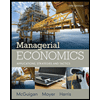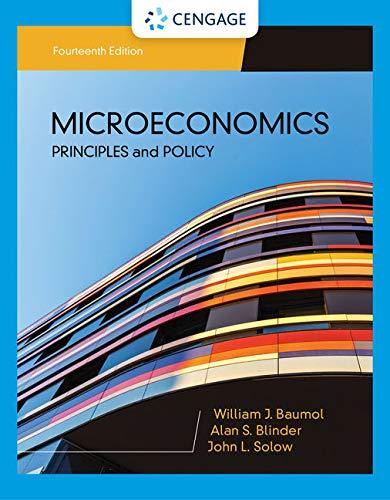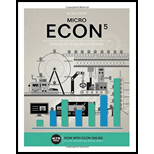
As the owner of Barney’s Broilers—a fast-food chain—you see an increase in the
Want to see the full answer?
Check out a sample textbook solution
Chapter 3 Solutions
Managerial Economics And Business Strategy 9th Edition (without Access Code)
- For a certain health insurance policy, losses are uniformly distributed on the interval [0, b].The policy has a deductible of $180 and the expected value of the non-reimbursed portionof a loss is $144. Calculate barrow_forwardfacebook (not Mark Zuckerberg) would do which action according the Circular Flow diagram? Buys, but does not sell. Does not sell nor buys. Sell, but does not buy. Sell and Buy (or Rent).arrow_forwardIt would be impossible for this economy to produce? dryers 100 90 C 80 70 A 60 50 D B 40 30+ 20- 10 10 20 30 40 50 60 70 80 OD C OA B washers 13arrow_forward
- Perusahaan IKBP ingin mendirikan usaha restaurant makanan sehat di tawangmangu, dimana didalam perhitungannya ada beberapa biaya yang akan muncul dalam perhitungan usaha ini, diantaraya : Biaya Tempat Usaha Biaya Renovasi tempat sendiri senilai Rp 15.000.000,- (kondisi ini muncul jika IKBP memilih untuk tidak menyewa ruko tempat lain) Biaya Sewa Tempat Senilai Rp 25.000.000,- (kondisi ini muncul jika IKBP memilih untuk menyewa tempat lain) Di segala kondisi IKBP menganggarkan ada penyusuatan aktiva tetap sebesar 2.5% Biaya Overhead untuk tempat Usaha dianggarkan Rp 2.000.000,- per bulan Biaya Tenaga Kerja Budget gaji karyawannya ada 2 dengan masing-masing gajinya per orang Rp 2.000.000,-/ bulan Biaya Modal Usaha Biaya bunga bank karena meminjam di perbankan sebesar 12% setahun (kondisi ini muncul jika ingin meminjam dari bank) Biaya dari dana talangan pihak Yayasan sebesar 5% (kondisi biaya ini muncul jika tidak ingin memanfaatkan pinjaman dari perbankan) Biaya dengan meminjam…arrow_forwardA monopolist had the following fixed costs and marginal revenue and costs for each unit of production: 0 units where fixed costs are 10 1 unit where MR = 60 & MC = 20 & FC = 10 2 units where MR = 50 & MC = 30 & FC = 10 3 units where MR = 45 & MC = 38 & FC = 10 4 units where MR = 40 & MC = 40 & FC = 10 How many units should the firm produce and why?arrow_forwardRespond to this post. Hello Professor, A rise in consumption in the economy would cause an increase in aggregate demand. Therefore, when consumers spend money on everyday goods and services, it not only helps to stimulate economic growth, but it could also present potential issues like unsustainable debt levels or inflation. I believe that it would be beneficial to consider such factors and adopt a purchasing strategy to help navigate the challenges posed by inflation or unsustainable debt levels. First, do you think our business will be affected because inflation is rising? How? Yes, I do believe that the business will be affected because of inflationary pressures. Inflation rising will affect the cost of goods, services, and labor, which could lead to higher operating expenses. The potential reduction of profit margin because of inflation could lead to a smaller percentage of revenue being retained as profit. Therefore, inflation rising will force us to raise prices for…arrow_forward
- Answer question a, b, d, and earrow_forwardBzbsbsbdbdbdbdarrow_forwardRecent research indicates potential health benefits associated with coffee consumption, including a potential reduction in the incidence of liver disease. Simultaneously, new technology is being applied to coffee bean harvesting, leading to cost reductions in coffee production. How will these developmentsaffect the demand and supply of coffee? How will the equilibrium price and quantity of coffee change? Use both words and graphs to explain.arrow_forward
 Managerial Economics: A Problem Solving ApproachEconomicsISBN:9781337106665Author:Luke M. Froeb, Brian T. McCann, Michael R. Ward, Mike ShorPublisher:Cengage Learning
Managerial Economics: A Problem Solving ApproachEconomicsISBN:9781337106665Author:Luke M. Froeb, Brian T. McCann, Michael R. Ward, Mike ShorPublisher:Cengage Learning Managerial Economics: Applications, Strategies an...EconomicsISBN:9781305506381Author:James R. McGuigan, R. Charles Moyer, Frederick H.deB. HarrisPublisher:Cengage Learning
Managerial Economics: Applications, Strategies an...EconomicsISBN:9781305506381Author:James R. McGuigan, R. Charles Moyer, Frederick H.deB. HarrisPublisher:Cengage Learning Microeconomics: Private and Public Choice (MindTa...EconomicsISBN:9781305506893Author:James D. Gwartney, Richard L. Stroup, Russell S. Sobel, David A. MacphersonPublisher:Cengage Learning
Microeconomics: Private and Public Choice (MindTa...EconomicsISBN:9781305506893Author:James D. Gwartney, Richard L. Stroup, Russell S. Sobel, David A. MacphersonPublisher:Cengage Learning Economics: Private and Public Choice (MindTap Cou...EconomicsISBN:9781305506725Author:James D. Gwartney, Richard L. Stroup, Russell S. Sobel, David A. MacphersonPublisher:Cengage Learning
Economics: Private and Public Choice (MindTap Cou...EconomicsISBN:9781305506725Author:James D. Gwartney, Richard L. Stroup, Russell S. Sobel, David A. MacphersonPublisher:Cengage Learning Microeconomics: Principles & PolicyEconomicsISBN:9781337794992Author:William J. Baumol, Alan S. Blinder, John L. SolowPublisher:Cengage Learning
Microeconomics: Principles & PolicyEconomicsISBN:9781337794992Author:William J. Baumol, Alan S. Blinder, John L. SolowPublisher:Cengage Learning





